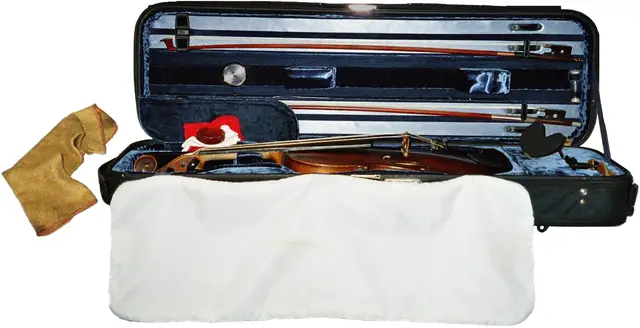Violins can be irreversibly damaged from incorrect storage. Damage can include wood warping, broken bridges and sound posts, and cracks in the body.
Violins can also be expensive and are capable of lasting well over 200 years. It’s therefore very important to store your violin correctly, especially long term. Loosening strings, adding extra support to the bridge, and storing in a climate-controlled area are some examples of how Violins should be stored.
In this article, we’ll cover every detail you need to keep your violin in top condition even when storing long-term.
Summary of How Best to Store a Violin Long-Term
Incorrect long-term storage of Violins can affect their structural integrity and sound quality. The two most important things are to keep your Violin in a climate-controlled area and in a safe spot away from bumps and falls. This will avoid warping or cracked wood and costly accidents.
Table of Contents
What Are the Top Tips on How to Safely Store a Violin Long-Term?
Violins are delicate and expensive. Significant damage can be caused by defective storage.
To avoid this and make sure that the violin stays in good shape, here are some of our best tips for long-term violin storage.
Tip 1: Clean Up the Violin
Vacuum the violin lightly to remove dust, dust mites, and any other tiny substances. This minimizes the possibility of any damage to the wood caused by dirt or small bugs.
It would be best to wipe the violin inside and out with a specialized microfiber cloth to finish cleaning all the surfaces thoroughly. Wipe the strings lightly as well.
Tip 2: Loosen Up the Strings
Loosen up the strings of the violin just a little bit for long-term storage. Catgut strings would need more slacking.
That’s because seasonal changes as well as the passing of time can increase the tension of the strings, and that could affect the whole structure of the violin.
Excessive slacking should be avoided as well. All the different parts of the violin are connected directly or indirectly. Having correctly tightened strings keeps the violin in proper shape. Overly loose strings could affect the soundpost to the point that it might fall.
A strict balance should be achieved by loosening up the strings to the right tension, no more and no less.
Tip 3: Add Extra Support for the Bridge if Necessary
The bridge is easily affected by changes in temperature, humidity, and decreased string tension. It’s not uncommon to find the bridge warped after a few years of storage.
It’s necessary then to give it an extra bit of support using soft padding. The aim is to keep it in place, and at the same time, avoid the unwanted effects of humidity.
Tip 4: Wrap the Violin in Soft Cloth
Delicate items naturally require an equally soft wrapping to keep them intact. Silk is among the best materials for that, but unfortunately, it isn’t readily available. The next best thing is satin, and that can be found in the form of a ready-made bag for the violin.
This material keeps the dust away while the violin is in storage. Some people would rather use a microfiber cloth to absorb any extra humidity, along with its protective job. This is only necessary at locations known to have high levels of humidity.
Tip 5: Add Another Layer of Bubble Wrap
You might’ve noticed that most sensitive items are often shipped inside multiple layers of bubble wrap. This protective measure has saved numerous objects from damage, even after receiving a bump or falling off.
This isn’t a necessary step, but it’s definitely useful. Bubble wrap is an effective shock absorber, and it would apply slight pressure on the violin that would minimize any morphing, warping, or bending in the various components of the violin.
Finally, put the well-wrapped violin inside a padded sturdy case. Some of these violin cases are equipped with an internal built-in hygrometer. This is necessary to optimize the violin’s storage conditions.
Tip 6: Place the Violin in Climate-Controlled Storage
Violins rarely withstand extreme temperature fluctuations, an extra humid environment, or one that’s too dry. These factors warp the wood, spoil it, bend the bridge, and often damage the strings.
That’s why we highly recommend storing the violin in climate-controlled rooms. This type of storage is readily available in many places.
The alternative is to store the violin in a room that’s not too exposed to the elements. For example, the backyard, the garage, and the attic are all unsuitable for storing musical instruments.
Tip 7: Make Sure the Violin is in a Secure Spot
Place the violin case in a spot where it won’t fall, might be accessible to rodents, is near any heaters, or close to water pipes.
Also, make sure no other boxes or heavy items are ever added on top of it. This could easily damage the violin, despite the hard case. The excessive weight and consistent pressure might easily overcome the protection of the case.

Is It Bad for a Violin to Store it Long-Term?
Violins are intricate instruments made for consistent use. A player generally practices or performs, then gives the violin the daily care it needs.
Subjecting the stored violin to extreme changes in temperature, or humidity, would cause significant damage. Also, putting heavy objects on its case, letting it take a fall, or leaving the violin accessible to rodents. These are all negative conditions that should definitely be avoided.
However, following the right procedure to store a violin long-term would minimize its deterioration. The good news is that many musicians store their instruments for years, and then retrieve them in good condition.
Violins that have been in long storage often need a reviving period, plus some routine maintenance and final adjustment. They might sound a bit off for a while, but that’s expected. After a breaking-in period, they usually return to their old glory.
Does a Violin Need to Be Played Regularly?
Playing the violin regularly keeps it in great condition. Violinists generally maintain their instruments before and after performing, which is considered good practice. One theory around why older violins sound so good is that constant playing changes the structure of the wood, making it more resonant.
The wood, strings, and various parts of the violin are under daily scrutiny of the violin, so if something is off, it’s fixed right away. That way, the audio quality stays at a consistent level.
Can a Violin Be Stored on the Floor?
Leaving a violin on the floor is risky business! it’s among the big no-nos of storing any musical instrument.
That’s because this is a vulnerable spot, where anyone can step on the violin, or a pet can easily treat it as a toy. It’s also where the violin would collect dust and dirt, and if there’s water leakage nearby, it would get there first.
The same applies to leaving the violin on a chair, on the bed, or on the kitchen counter. Violins should be stored in their cases, in a safe place. Even if that’s for short-term storage.
How Long Can a Violin Last?
Violins could survive for astoundingly long times. The average is 200 years, but there are violins in auction rooms and in the possession of musicians that far exceed that.
This often comes down to proper storage and regular maintenance.
Can a Violin Be Stored in the Cold?
The cold weather could have detrimental effects on a violin. Several reasons are responsible for that:
- Wood is an organic material that contracts as the temperature drops.
- The internal moisture of wood decreases as its molecules are pushed closer together due to wood contraction.
- The various parts of the violin are made from different types of wood, and each type contracts at an individual rate. This causes cracks, loose parts, and warping.
- The glue used to bind the violin together often disintegrates under the push and pull of the shrinking wood. This creates gaps, cracks, and some parts separate at the seams.
- The soundpost, bridge, and pegs are all affected by the changes in temperature and humidity that accompany the chilly weather.
- Finally, the audio quality of the violin suffers substantially from all these issues.
Can You Store a Violin Upright?
Putting a violin on a stand and showing it off seems nice at first, but it’s not beneficial for the instrument. In this position, it could also be knocked off, or suffer from all sorts of environmental effects.
Keeping the violin in a closed case is preferable. It’s better to keep it flat on its back, but if there’s only enough space for putting it in a vertical position, then that shouldn’t be a problem. The important thing is to use a hard case and make sure it’s stable.
Can a Violin Be Stored Outside?
Storing a violin out under the elements is a guaranteed way to damage it quickly. The variations in temperature and humidity compromise the structure of the violin.
It’s best then to store it somewhere where the internal climate is regulated, or at least, less extreme.
What Sort of Case Should a Violin Be Stored in?
The minimum requirement is using a hard case with velvet internal padding. The case should match the size of the violin exactly without any slacks.
Some cases will also come with a humidity reader, making it easy to choose where exactly to store the violin case.
Conclusion
Violins are delicate instruments that are capable of surviving for hundreds of years. With the right care and regular maintenance, you can keep your violin in stellar condition.
Even if you have to put it in long-term storage, you can still expect it to perform well as you unpack it. Just follow the simple tips outlined in this article.
